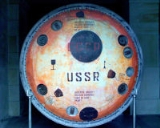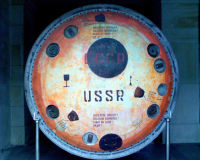
Soyuz 30
Encyclopedia
Soyuz 30 was a 1978 manned Soviet space flight to the Salyut 6
space station
. It was the sixth mission to and fifth successful docking at the orbiting facility. The Soyuz 30 crew were the first to visit the long-duration Soyuz 29
resident crew.
Soyuz 30 carried Pyotr Klimuk
and Mirosław Hermaszewski, the first Polish
cosmonaut, aloft.
 The second Intercosmos
The second Intercosmos
mission was launched 27 June 1978 to the orbiting Salyut 6 space station.
The Soyuz docked with the space station 29 June, and cosmonauts Klimik and Hermaszewski were greeted by Vladimir Kovalyonok
and Aleksandr Ivanchenkov
, the resident crew who had been on-board for 12 days. For the third time, the Salyut was a four-man orbiting space laboratory.
The activities of the Soyuz 30 crew, however, were severely curtailed so as not to interfere with the Soyuz 29 crew. On the Soyuz 29 crew's rest day, the international crew had to stay in their Soyuz to perform their experiments. Nevertheless, Hermaszewski conducted many experiments. One was crystallization experiments which produced 47 grams of cadmium tellurium mercury semiconductor
s for use by infra-red detectors on board the station. The yield was far greater - 50 % compared to 15 % - than ground-based experiments.
The Soyuz 30 crew was trained, as all international crews, in the use of the MKF-6M camera. Training in part took place on a Tu-134 flying at 10 km to best mimic conditions on the station. Hermaszewski photographed Poland in co-ordination with aircraft taking close-up photos, but bad weather over Poland limited the photo sessions. They additionally filmed the Aurora Borealis.
Hermaszewski participated in medical experiments which measured lung capacity and the heart during exercise and in a pressure suit. One experiment, which all four on board the station participated in, was Smak, a taste experiment which sought answers to why some food was less palatable in weightlessness.
The Soyuz 30 crew packed their experiments into their capsule and returned to earth 5 July, landing in a Rostov state farm field 300 km west of Tselinograd.
Salyut 6
Salyut 6 , DOS-5, was a Soviet orbital space station, the eighth flown as part of the Salyut programme. Launched on 29 September 1977 by a Proton rocket, the station was the first of the 'second-generation' type of space station. Salyut 6 possessed several revolutionary advances over the earlier...
space station
Space station
A space station is a spacecraft capable of supporting a crew which is designed to remain in space for an extended period of time, and to which other spacecraft can dock. A space station is distinguished from other spacecraft used for human spaceflight by its lack of major propulsion or landing...
. It was the sixth mission to and fifth successful docking at the orbiting facility. The Soyuz 30 crew were the first to visit the long-duration Soyuz 29
Soyuz 29
Soyuz 29 was a 1978 manned Soviet space mission to the Salyut 6 space station. It was the fifth mission, the fourth successful docking, and the second long-duration crew for the orbiting station...
resident crew.
Soyuz 30 carried Pyotr Klimuk
Pyotr Klimuk
Pyotr Ilyich Klimuk Klimuk attended the Leninski Komsomol Chernigov High Aviation School and entered the Soviet Air Force in 1964. The following year, he was selected to join the space programme.His first flight was a long test flight on Soyuz 13 in 1973...
and Mirosław Hermaszewski, the first Polish
Poles
thumb|right|180px|The state flag of [[Poland]] as used by Polish government and diplomatic authoritiesThe Polish people, or Poles , are a nation indigenous to Poland. They are united by the Polish language, which belongs to the historical Lechitic subgroup of West Slavic languages of Central Europe...
cosmonaut, aloft.
Crew
Backup crew
Mission parameters
- Mass: 6800 kg (14,991.4 lb)
- Perigee: 197.6 km (122.8 mi)
- Apogee: 261.3 km (162.4 mi)
- Inclination: 51.66°
- Period: 88.83 minutes
Mission highlights

Intercosmos
Interkosmos was a space program of the Soviet Union designed to include members of military forces of allied Warsaw Pact countries in manned and unmanned missions...
mission was launched 27 June 1978 to the orbiting Salyut 6 space station.
The Soyuz docked with the space station 29 June, and cosmonauts Klimik and Hermaszewski were greeted by Vladimir Kovalyonok
Vladimir Kovalyonok
-Honours and awards:* Hero of the Soviet Union, twice * Order of Merit for the Fatherland, 3rd class * Order of Military Merit * Three Orders of Lenin...
and Aleksandr Ivanchenkov
Aleksandr Ivanchenkov
Aleksandr Sergeyevich Ivanchenkov is a retired Soviet cosmonaut who flew as Flight Engineer on Soyuz 29 and Soyuz T-6, he spent 147 days, 12 hours and 37 minutes in space....
, the resident crew who had been on-board for 12 days. For the third time, the Salyut was a four-man orbiting space laboratory.
The activities of the Soyuz 30 crew, however, were severely curtailed so as not to interfere with the Soyuz 29 crew. On the Soyuz 29 crew's rest day, the international crew had to stay in their Soyuz to perform their experiments. Nevertheless, Hermaszewski conducted many experiments. One was crystallization experiments which produced 47 grams of cadmium tellurium mercury semiconductor
Semiconductor
A semiconductor is a material with electrical conductivity due to electron flow intermediate in magnitude between that of a conductor and an insulator. This means a conductivity roughly in the range of 103 to 10−8 siemens per centimeter...
s for use by infra-red detectors on board the station. The yield was far greater - 50 % compared to 15 % - than ground-based experiments.
The Soyuz 30 crew was trained, as all international crews, in the use of the MKF-6M camera. Training in part took place on a Tu-134 flying at 10 km to best mimic conditions on the station. Hermaszewski photographed Poland in co-ordination with aircraft taking close-up photos, but bad weather over Poland limited the photo sessions. They additionally filmed the Aurora Borealis.
Hermaszewski participated in medical experiments which measured lung capacity and the heart during exercise and in a pressure suit. One experiment, which all four on board the station participated in, was Smak, a taste experiment which sought answers to why some food was less palatable in weightlessness.
The Soyuz 30 crew packed their experiments into their capsule and returned to earth 5 July, landing in a Rostov state farm field 300 km west of Tselinograd.

